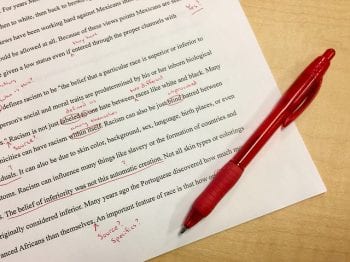Understanding Common Knowledge

When students ask me about plagiarism and citation issues, two questions inevitably come up:
- “How do I have to change to not be accused of plagiarism?” (A question I addressed here)
- “Do I have to cite X?”
Since failure to cite information is not seen as serious as failure to cite text, the first question gets the lion’s share of attention. However, it’s actually the second question that’s often more difficult answer.
That’s because determining what facts and information need citation is not a straightforward one and, very often, the information given to students on the issue isn’t helpful.
The reason is because of one very vague term “Common knowledge.” Though most students and authors know they don’t have to cite common knowledge, there’s little guidance on what exactly what information can be considered “common”
The reason for that is simple: There is no easy answer. Determining what is and is not common knowledge requires looking not just at the information itself, but also the audience it’s intended for.
The Basics of Common Knowledge
Most students and authors understand that you don’t need to cite work that you created, including ideas and text, and that you don’t need to cite facts and information that are common knowledge.
According to the academic integrity department at the Massachusetts Institute of Technology (MIT), common knowledge can be defined as “information that the average, educated reader would accept as reliable without having to look it up.”
This means that, for a piece of information to be considered common knowledge, it must be two things at the same time:
- Understood and known by your average reader
- Not controversial, meaning that it is simply accepted as fact
As such, a statement such as “1 Miles = 1.6 Kilometers” is likely to be fine without citation. It is broadly understood and there’s no controversy around it.
However, once you leave behind the most basic information, it gets more and more difficult to determine what is and is not common knowledge. The date of an obscure battle would likely require citation, unless the work is directed at experts in that time period. Likewise a statement such as “Humans have five senses” would require citation because there is significant controversy as to what does and does not constitute a sense.
This creates a real problem, the author, when determining what is and is not “common knowledge” has to anticipate both their audience’s understanding of the topic and their acceptance of the information being conveyed.
This, unfortunately, changes drastically from classroom to classroom. What is common knowledge in a graduate level history class will not always be as such in an eighth grade history class. Likewise, what’s common knowledge in an English class may not be in a physics class later that day.
There are also cultural, national and regional differences in what is and is not common knowledge. For example. parts of US history that are common knowledge in the states wouldn’t be in the UK and vice versa.
However, since authors aren’t psychic, they aren’t going to be able to perfectly predict what is and is not common knowledge to the reader. As such, mistakes are going to happen, including information that’s not cited when it should have been and information that is needless attributed.
Of those two, the latter is far less hazardous to one’s work but both can be avoided if possible.
Deciding What is Common Knowledge
When determining what is and is not common knowledge, MIT proposes a three questions to ask yourself:
- Who is my audience?
- What can I assume they already know?
- Will I be asked where I obtained my information?
The first question is the easiest. It’s simply asking ” Who is this paper for?” The answer could be as simple as a teacher, the general public or an audience of relative experts in a field. One doesn’t have to anticipate every possible reader of a work, just the general audience it is for.
The second and third questions, however, are the more difficult. Anticipating what your audience knows and accepts is inherently difficult. However, it’s generally best to assume that your audience is, as MIT put it, educated has a reasonable amount of understanding, if not expertise, on the subject.
As a general rule, you should always cite facts, figures and information that you obtained solely through your research in the paper. Even if it is common knowledge to the person reading it, it wasn’t common knowledge to you when you started work.
Similarly, you generally do not need to cite information that was taught in the classroom you’re presenting the paper. If the instructor taught it, it’s safe to assume that they know it and accept it as fact, as with the other students.
In the end, if you’re unsure about what is or is not common knowledge, the best thing to do is either ask your instructor or, if that isn’t possible, cite the content.
Though excessive and needless citation can hurt a paper, it harms it far less than leaving out citations that should have been included.
Bottom Line
When it comes to missing plagiarism, missing a citation on a piece of information or an idea is generally considered less egregious than plagiarized text. Where one is viewed as a mistake, the other is viewed as cheating. One hurts a grade, one hurts academic careers.
Still, it is best to take make sure you understand the rules that surround citing facts and information. It not only prevents accusations of plagiarism but, if done well, it bolsters your arguments and makes your work much stronger.
To that end, following the rules above can help greatly in determining what is and is not common knowledge though. However, if you still find yourself stuck, your best bet is to either speak with your instructor/editor or, if that’s not possible, cite the source.
When it comes to a choice between over-citing and under-citing, it’s clear which one is preferred.
Want to Reuse or Republish this Content?
If you want to feature this article in your site, classroom or elsewhere, just let us know! We usually grant permission within 24 hours.
